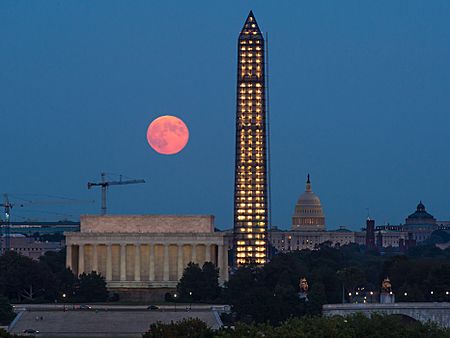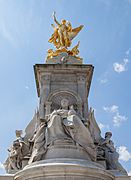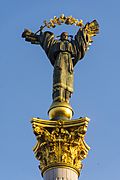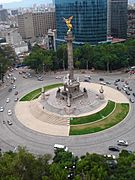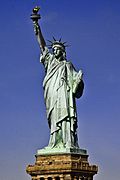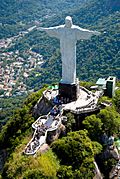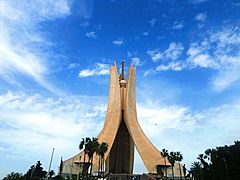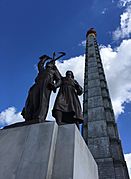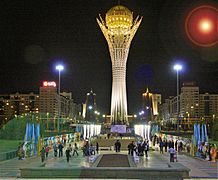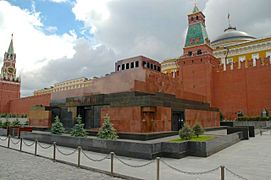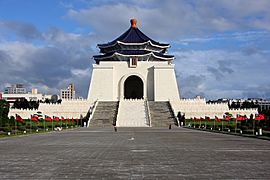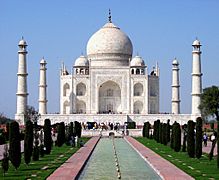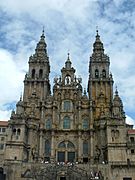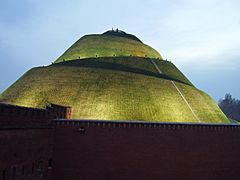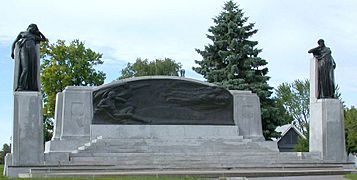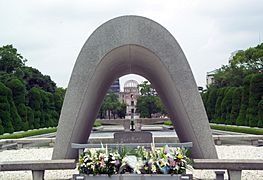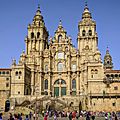Monument facts for kids

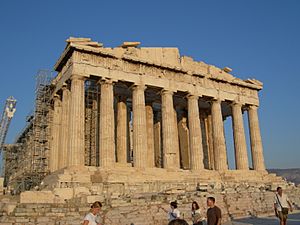
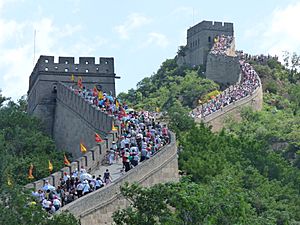
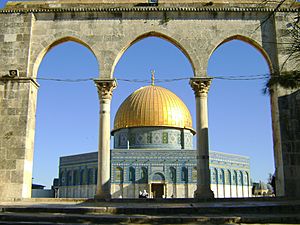
A monument is a type of—usually three-dimensional—structure that was explicitly created to commemorate a person or event, or which has become relevant to a social group as a part of their remembrance of historic times or cultural heritage, due to its artistic, historical, political, technical or architectural importance. Examples of monuments include statues, (war) memorials, historical buildings, archeological sites, and cultural assets. If there is a public interest in its preservation, a monument can for example be listed as a UNESCO World Heritage Site.
Contents
Etymology
The origin of the word "monument" comes from the Greek mnemosynon and the Latin moneo, monere, which means 'to remind', 'to advise' or 'to warn', suggesting a monument allows us to see the past thus helping us visualize what is to come in the future. In English the word "monumental" is often used in reference to something of extraordinary size and power, as in monumental sculpture, but also to mean simply anything made to commemorate the dead, as a funerary monument or other example of funerary art.
Creation and functions
Monuments have been created for thousands of years, and they are often the most durable and famous symbols of ancient civilizations. Prehistoric tumuli, dolmens, and similar structures have been created in a large number of prehistoric cultures across the world, and the many forms of monumental tombs of the more wealthy and powerful members of a society are often the source of much of our information and art from those cultures. As societies became organized on a larger scale, so monuments so large as to be difficult to destroy like the Egyptian Pyramids, the Greek Parthenon, the Great Wall of China, Indian Taj Mahal or the Moai of Easter Island have become symbols of their civilizations. In more recent times, monumental structures such as the Statue of Liberty and Eiffel Tower have become iconic emblems of modern nation-states.
Monuments are frequently used to improve the appearance of a city or location. Planned cities such as Washington D.C., New Delhi and Brasília are often built around monuments. For example, the Washington Monument's location was conceived by L'Enfant to help organize public space in the city, before it was designed or constructed. Older cities have monuments placed at locations that are already important or are sometimes redesigned to focus on one.
Structures created for others purposes that have been made notable by their age, size or historic significance may also be regarded as monuments.
Types
- Benchmarks placed by a government agency or private survey firm.
- Buildings designed as landmarks, usually built with an extraordinary feature, such being designed as the tallest, largest, or most distinctive design, e.g., the Burj Khalifa in Dubai, the world's tallest structure.
- Cenotaphs (intended to honor the dead who are buried elsewhere) and other memorials to commemorate the dead, usually war casualties, e.g., India Gate and Vimy Ridge Memorial, or disaster casualties, such as the Titanic Memorial, Belfast.
- Church monuments to commemorate the faithful dead, located above or near their grave, often featuring an effigy, e.g., St. Peter's Basilica or the medieval church Sta Maria di Collemaggio in L'Aquila.
- Columns, often topped with a statue, e.g., Berlin Victory Column, Nelson's Column in London, and Trajan's Column in Rome.
- Eternal flames that are kept burning continuously, usually lit to honor unknown soldiers, e.g., at the Tomb of Unknown Soldier in Moscow or at the John F. Kennedy gravesite in Virginia's Arlington National Cemetery.
- Fountains, water-pouring structures usually placed in formal gardens or town squares, e.g., Fontaines de la Concorde and Gardens of Versailles.
- Gravestones, small monuments to the deceased, placed at their gravesites, e.g., the tombs and vaults of veterans in Les Invalides and Srebrenica Genocide Memorial.
- Mausoleums and tombs to honor the dead, e.g., the Great Pyramid of Giza, Libyco-Punic Mausoleum of Dougga and Taj Mahal.
- Monoliths erected for religious or commemorative purposes, e.g., Stonehenge.
- Mosque Monuments, places of worship that generally have domes and minarets that stand out against the skyline. They also usually feature highly skilled Islamic calligraphy and geometric artwork, e.g., the Mosque of the Prophet.
- Mounds erected to commemorate great leaders or events, e.g., Kościuszko Mound.
- Obelisks, usually erected to commemorate great leaders, e.g., Cleopatra's Needle in London, the National Monument ("Monas") in Central Jakarta, and the Washington Monument in Washington, D.C.
- Palaces, imposing royal residences designed to impress people with their grandeur and greatness, e.g., Forbidden City in Beijing, Palace of Versailles, and Schwerin Palace in Schwerin.
- Searchlights to project a powerful beam of light, e.g., Tribute in Light in the National September 11 Memorial & Museum in New York City, commemorating the September 11 attacks of 2001.
- Statues of famous individuals or symbols, e.g., the Niederwalddenkmal (Germania) in Hesse, Liberty Enlightening the World (commonly known as the Statue of Liberty) in New York City, and The Motherland Calls in Volgograd.
- Temples or religious structures built for pilgrimage, ritual or commemorative purposes, e.g., Borobudur in Magelang and Kaaba in Mecca.
- Terminating vistas, layout design for urban monuments on the end of an avenue, e.g., Opera Garnier in Paris.
- Triumphal arches, almost always to commemorate military successes, e.g., the Arch of Constantine in Rome and Arc de Triomphe de l'Étoile in Paris.
- War memorials, e.g., the Iwo Jima Memorial in Arlington, VA, the Laboe Naval Memorial, the Lorraine American Cemetery and Memorial in St Avold, and the Soviet War Memorial in Berlin.
Examples of notable monuments
-
Victoria monument in London, a memorial to Queen Victoria of the British Empire
-
The Statue of Liberty, the symbol of the United States' freedom
-
The Cristo Redentor, a modern religious monument in Brazil
-
The Maqam Echahid, in Algiers, iconic concrete monument commemorating the Algerian war for independence
-
The Eiffel Tower, in Paris, a monument commemorating the French Revolution for its centenary
-
Monas in Jakarta, commemorates the Indonesian struggle for independence
-
The Juche Tower, a symbol of North Korea's "self reliant" Juche political stance
-
Azadi tower in Tehran, commemorates the 2,500 years of the Persian Empire and the history of Iran
-
Brandenburg Gate in Berlin, national symbol of Germany and its unity
-
Lenin mausoleum in Moscow, an enduring symbol of Soviet Union Communism and Cold War
-
The Chiang Kai-shek Memorial in Taipei is a monument to honor Chiang Kai-shek
-
The Cathedral of Santiago de Compostela where Saint James is buried
-
Kościuszko Mound, Poland commemorates Tadeusz Kościuszko
-
The Bell Telephone Memorial, commemorates the invention of the telephone, Brantford, Ontario
-
The Hiroshima Cenotaph and Atomic Bomb Dome to remember the victims of August 6, 1945 atomic bombing
Images for kids
-
The Monument to Nicholas I from Saint Isaac's Square in Saint Petersburg (Russia)
-
The Colosseum Flavian amphitheatre in Rome, a popular monument of the Roman Empire.
-
The Christ the King, in Almada, Portugal, has become one of the most visited national monuments.
-
The Washington Monument in Washington, D.C., which honors the first president of the United States, George Washington, is the world's tallest obelisk.
-
Christ the Redeemer, a modern religious monument in Brazil
-
Brisbane City Hall, national symbol of democracy
-
Chairman Mao Memorial Hall is located on the Tiananmen Square, where the Beijing Gate of China used to stand
-
The Cathedral of Santiago de Compostela where Saint James is buried
-
The Lincoln Memorial in Washington, D.C. honors American President Abraham Lincoln
See also
 In Spanish: Monumento para niños
In Spanish: Monumento para niños


